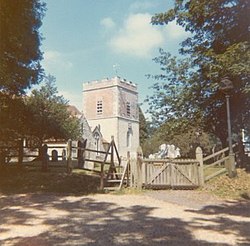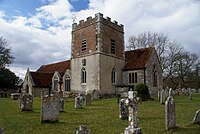Boldre
| Boldre | |
| Hampshire | |
|---|---|
 Boldre in the New Forest | |
| Location | |
| Grid reference: | SZ315981 |
| Location: | 50°46’56"N, 1°33’12"W |
| Data | |
| Population: | 2,003 (2011) |
| Post town: | Lymington |
| Postcode: | SO41 |
| Dialling code: | 01590 |
| Local Government | |
| Council: | New Forest |
| Parliamentary constituency: |
New Forest East |
Boldre is a small, scattered village in the New Forest, in the south of the Forest, above the broadening waters of the Lymington River, two miles north of Lymington. The 2001 census recorded a parish population of 1,931, and the 2011 census 2,003.
The parish has a few campsites and a tourist caravan site, also visitor parking lots around its mixed woodland and heath hamlet of Norley Wood.
A hundred years ago, W. H. Hudson, in Hampshire Days, called the countryside north of Lymington, round the villages of Pilley and Boldre, "a land of secret, green, out-of-the-world places." Today it contains large homes and is more accessible.
The wider parish include the hamlets of Battramsley, Sandy Down, Pilley, Bull Hill, Norley Wood, Portmore, South Baddesley, and Walhampton.
The village pub-restaurant is the Red Lion. There is also a Church of England-ethos school, William Gilpin School on Pilley Hill, named after the famed local Vicar. The village has a working men's club, the Boldre Club, which is one of the oldest in te Forest.
Contents
Church
The parish church, St John the Baptist, stands to the north-east of the main knot of the village. It has its origin in a church built at Boldre by William the Conqueror immediately after the afforestation of this corner of Hampshire in 1079, although there may have been a Saxon church here. For centuries Boldre was the Mother Church of the southern New Forest, a situation that dates back to the twelfth century. The church df today was built in around 1200, work of which age is found in the south aisle, then north aisle, and the tower. In the late 13th century the nave and aisle were lengthened and the chancel rebuilt in th 14th century. Later work includes the top stage of the tower, built in 1697. Restoration was carried out in 1855 and in 1918. It is a Grade II* listed building.[1]
The Church commemorates HMS Hood because the ship's final captain, Admiral Lancelot Holland, was a regular worshipper at the church before Second World War. The Hood Association attended and promoted an Annual Boldre Service, no longer widely promulgated, but the largest public service of remembrance for the Hood, generally the week before their reunion dinner and service of remembrance always on the Saturday nearest to 24 May.
After Second World War notable vicar John Hayter served the parish, who had spent much of the war as a padre in the ill-treated, malnourished Changi Prison during the Japanese occupation of Singapore. He wrote of his experiences.[2]
History
The Domesday Book contains a substantial entry on the Hundred of Boldre, where it is recorded as "Bouvre". This is probably a Norman corruption of "Bol Re" (a plank over a river). The church replaced an earlier one from the 13th century and a huge iron key which was used by the monks from Beaulieu Abbey is still used to unlock the doors.
Gilpin and the picturesque
Former residents include William Gilpin, who was the village parson and lived at Vicars Hill. He was famed for his wealth of knowledge about the New Forest, and its flora and fauna. He is buried in the churchyard of St John the Baptist beside an old maple tree. He died in 1804 at the age of 80 and it is inscribed:
- 'In a quiet mansion beneath this stone, secured from the afflictions and still more dangerous enjoyments of life, lie the remains of William Gilpin, sometime vicar of this parish, together with the remains of Margaret his wife....who "await patiently the joy of waking in a much happier place"...Here it will be a new joy to meet several of their good neighbours who now lie scattered in these sacred precincts around them.
Comyn's New Forest
Later, the Rev. Thomas Vialls, was quite absent, but made one of his rare appearances in the parish to conduct the wedding of his curate Henry Comyn and Philadelphia Heylyn in 1815. Comyn, brother of Lord Nelson's chaplain Stephen George Comyn, carried out a comprehensive census and register of the parish and in 1817 (which then included Sway and compiled the notebooks of Boldre. He sought to track the growth of religious dissent of parishioners, especially in a region of considerable conversion to Baptism, reflected in careful recording of Dissenters in his notebooks. The Baptist church at Beaulieu Rails (East Boldre) was founded in 1810 and at Sway in the west of the parish in 1816. He probably saw the Independents and Methodists as wayward Christians but less attractive. The records have been of use to genealogy and socio-religious history.[3]
Comyn also published a book entitled Substance of part of the lectures delivered in the United parishes of Boldre and Brockenhurst, which was printed and published by Galpine of Lymington. The British Library copy contains many amendments in Comyn's own hand.
Caroline Southey
Another who linked the village with literature was Caroline Bowles, who in 1839 married the poet Robert Southey.
Folklore
- Main article: Stratford Lyon
The local pub, the Red Lion, dates from the 17th century and is named after a creature of local folklore, the Stratford Lyon. Supposedly a giant red lion with a wild mane, yellow eyes, large teeth, and huge stag-like antlers, pulled from the ground by John Stratford, a verderer, in a nearby wood named Haresmede in the early 15th century. There have been recorded sightings of the monster as recently as the 20th century.[4]
Outside links
| ("Wikimedia Commons" has material about Boldre) |
References
- ↑ National Heritage List 1094785: Church of St John (Grade II* listing)
- ↑ John Hayter Priest in Prison Tynron Press 1991 ISBN 1-85646-051-7
- ↑ Jude James Comyn's New Forest (1985)
- ↑ History of the Red Lion Boldre, Christopher Tower Reference Library, Lyndhurst, 1989.
